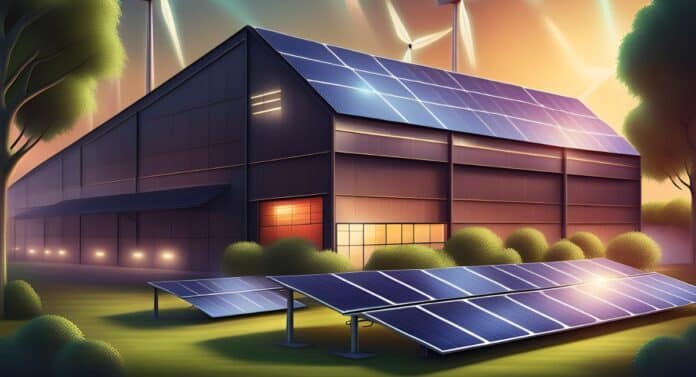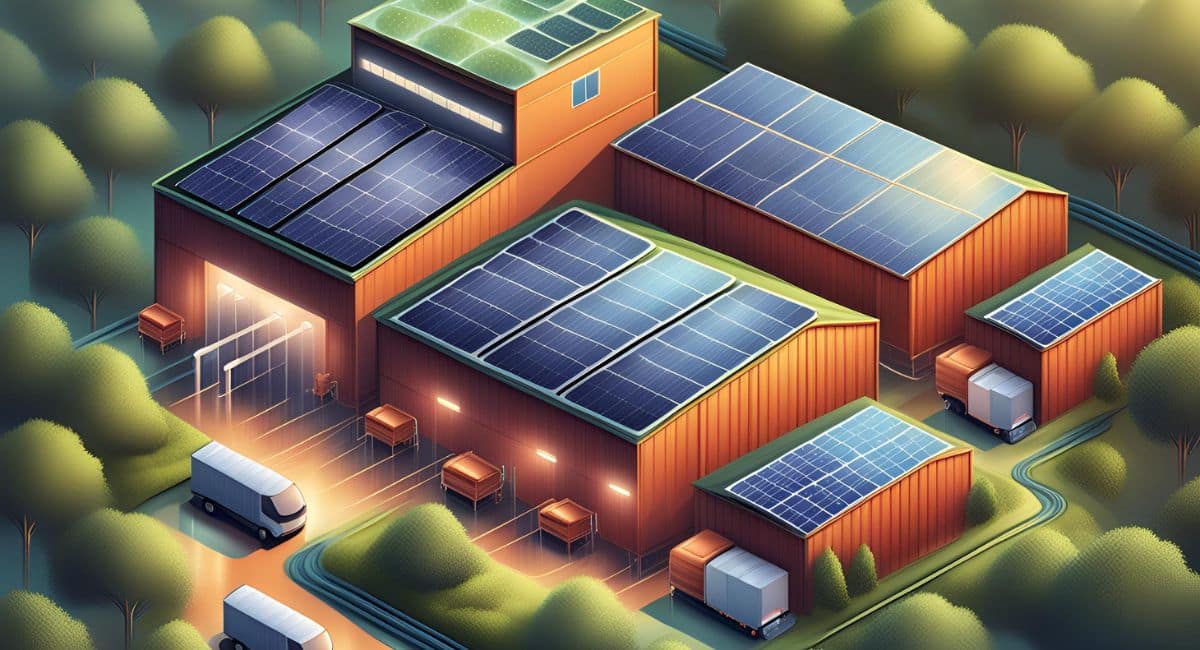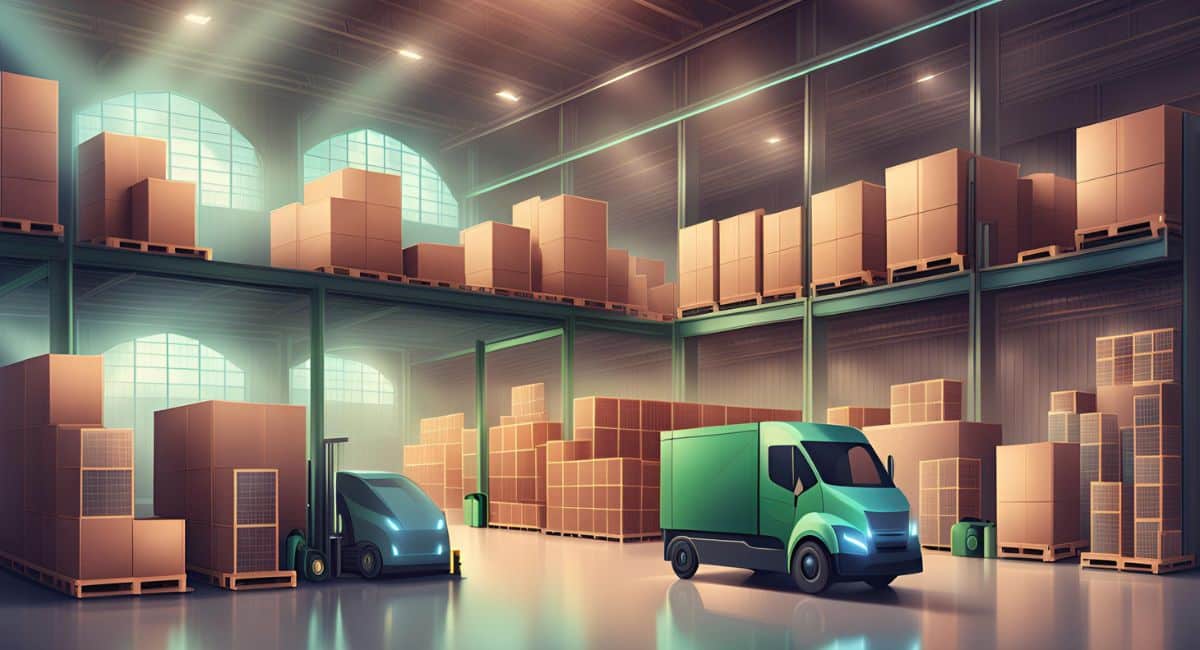A sustainable warehouse is a facility focused on reducing environmental impact. This include cutting energy use, utilising renewable resources, managing waste, and enhancing operational efficiency.
In today’s rapidly evolving business environment, sustainability has emerged as a critical factor for long-term success. A sustainable warehouse not only benefits the planet but also offers companies a more efficient and cost-effective way to manage their operations.
By adopting sustainable practices, businesses can future-proof their operations while positively contributing to environmental conservation.
This guide will take you through the essential steps of building and maintaining a sustainable warehouse, from understanding what it is to implementing best practices that ensure long-term efficiency and environmental impact.
A key tool in achieving this is the use of a Warehouse Management System (WMS), which plays a pivotal role in optimising operations and promoting sustainability.
Key Takeaways
|
Table of Content:
Table of Content
What is a Sustainable Warehouse?
A Sustainable warehouse is a storage facility designed and operated with the primary goal of reducing environmental impact. This includes reducing energy consumption, utilising renewable resources, managing waste responsibly, and promoting overall operational efficiency.
From energy-efficient lighting and automated systems to waste reduction strategies, sustainable warehouses are built with the goal of reducing their environmental footprint.
An essential component of this is the integration of a Warehouse Management System (WMS), which helps businesses track inventory, manage resources more effectively, and reduce waste through better planning and automation. By leveraging technology, warehouses can become more efficient while also supporting warehouse sustainability.
Key Features of a Sustainable Warehouse
When designing a sustainable warehouse, certain features are crucial to ensure it meets both operational and environmental goals. The following key features can be incorporated into the design and daily operations of a sustainable facility:
- Energy-Efficient Design: Energy consumption is a major concern for warehouses, which often require large amounts of lighting, heating, and cooling. By incorporating energy-efficient systems, such as LED lighting and advanced climate control, a sustainable warehouse can drastically reduce energy usage.
- Renewable Energy Usage: Many sustainable warehouses utilise renewable energy sources such as solar panels or wind turbines. This not only cuts down on operational costs but also helps in reducing the overall carbon footprint of the business. Additionally, a WMS Singapore solution can help monitor energy consumption and identify areas where efficiency can be improved.
- Water Conservation: Installing systems for rainwater harvesting and efficient water management can help reduce the amount of water needed for warehouse operations. Low-flow fixtures and recycled water systems are other examples of how warehouses can conserve water.
- Automation: The integration of warehouse management software (WMS) and automated storage and retrieval systems ensures greater efficiency and less human error, reducing waste and improving energy use. A WMS also helps optimise inventory management, reducing overstock and understock situations that lead to unnecessary waste.
Implementing a Warehouse Management System (WMS) not only boosts sustainability but also enhances operational safety and accuracy. If you’re looking to optimise your warehouse processes and reduce manual errors, now is the perfect time to explore a software solutions.
The WMS offers flexible pricing plans tailored to meet the needs of businesses of all sizes, ensuring you get the best value for your investment. Interested in learning more about the pricing schemes? Click the banner below to explore plans and find the perfect solution for your business!
Impact of a Sustainable Warehouse
Building a sustainable warehouse is not just about environmental responsibility. It offers a range of benefits that go beyond reducing carbon footprints. These impacts not only help the planet but also improve the efficiency and profitability of warehouse operations.
Let’s explore the major effects a sustainable warehouse can have on various aspects of your business, from environmental benefits to operational efficiency and community well-being.
Environmental Impact
The most significant benefit of a sustainable warehouse is its reduced environmental impact. By using renewable energy and adopting eco-friendly materials, businesses can significantly cut down on their carbon emissions.
These practices, when combined with sustainable logistics, contribute to a larger ecosystem of environmentally responsible operations. Implementing sustainable storage methods and reducing excess packaging can also have a profound impact on reducing waste.
A Warehouse Management System plays a crucial role in this by optimising the use of space and ensuring that inventory is managed efficiently. With real-time tracking, businesses can reduce the chances of over-ordering or letting products expire, both of which contribute to waste.
Additionally, the use of barcode tracking software enhances inventory accuracy, ensuring that products are easily located and efficiently distributed, reducing unnecessary transportation and energy consumption.
Operational Efficiency
A sustainable warehouse is not just environmentally friendly—it’s also more efficient. Automation technologies and energy-efficient systems help businesses cut operational costs. For instance, warehouse management software can help monitor inventory levels in real-time, ensuring that stock is managed efficiently and waste is minimised.
Furthermore, energy-efficient lighting and heating systems reduce overall energy consumption, saving businesses money in the long run. With the integration of a Warehouse Management System Singapore, businesses can ensure smoother operations, less downtime, and optimised workflows.
These systems allow managers to monitor every aspect of the warehouse, from inventory levels to the performance of energy systems, ensuring that everything runs as efficiently as possible.
Employee and Community Benefits
Sustainable warehouses are designed with the well-being of both employees and the surrounding community in mind. By reducing pollutants and noise levels, the warehouse becomes a healthier work environment.
Additionally, businesses that adopt sustainability practices tend to have a positive social impact on nearby communities, further enhancing their public image.
A Warehouse Management System also improves the safety and working conditions for employees. By automating many of the manual tasks involved in inventory management, businesses can reduce workplace injuries, improve accuracy, and create a more organised and productive work environment.
Key Components of a Sustainable Warehouse
Creating a truly sustainable warehouse requires a comprehensive approach that addresses several key elements. Each component plays an important role in reducing the warehouse’s environmental footprint while enhancing its overall efficiency.
By incorporating these components, businesses can ensure that their operations are both eco-friendly and cost-effective. Below, we delve into the essential parts that make a warehouse sustainable, from energy-efficient designs to advanced automation.
Energy-Efficient Design
Energy efficiency is one of the cornerstones of a sustainable warehouse. By incorporating LED lighting systems, advanced HVAC systems, and smart insulation, businesses can greatly reduce their energy consumption.
These energy-efficient designs also contribute to reducing greenhouse gas emissions, which is crucial for businesses aiming to meet global sustainability targets.
The integration of warehouse management systems further enhances these benefits by providing real-time data on energy usage, allowing businesses to adjust and optimise energy consumption where necessary.
Use of Renewable Energy
The integration of renewable energy sources, such as solar and wind power, is another critical component of a sustainable warehouse. This not only decreases dependence on non-renewable resources but also helps reduce operational costs in the long run.
Many businesses are adopting WMS Singapore solutions that support energy management, enabling better tracking of energy usage and identifying areas for improvement.
5 Best Practices for a Sustainable Warehouse
To build and maintain a truly sustainable warehouse, businesses should follow these best practices:
1. Optimise Energy Usage
Conducting regular energy audits is essential for identifying areas of improvement. By upgrading to energy-efficient lighting, optimising HVAC systems, and using motion-sensor lighting, warehouses can drastically cut down on energy consumption. These changes contribute to both cost savings and enhanced warehouse sustainability.
2. Utilise Sustainable Materials
The materials used in constructing and operating the warehouse can have a significant impact on its sustainability. Using eco-friendly building materials such as recycled steel or bamboo, as well as adopting sustainable storage solutions, can reduce the warehouse’s overall environmental footprint.
Additionally, businesses should focus on sustainable packaging materials to further reduce waste.
3. Implement Efficient Waste Management
Waste management is another critical area for a sustainable warehouse. Businesses can implement recycling programmes to manage waste more efficiently. Reducing excess packaging and properly segregating materials for recycling can minimise the amount of waste sent to landfills.
Warehouse management software can also be used to track waste and ensure that waste management practices are being followed.
4. Adopt Automation and Technology
By integrating automated systems and warehouse management systems (WMS), businesses can reduce waste, improve inventory accuracy, and streamline operations. Automation also reduces human error and energy use.
For instance, WMS Singapore providers offer advanced systems that help monitor stock levels, improve order accuracy, and reduce waste through better planning.
5. Optimise Transportation
Transportation plays a large role in logistics sustainability. Businesses should optimise their transportation routes to minimise fuel consumption and reduce emissions. The use of electric vehicles or alternative fuel vehicles is another step towards making the supply chain more sustainable.
Consolidating shipments and reducing the number of trips also reduces carbon emissions, contributing to more sustainable logistics operations.
Conclusion
Building a sustainable warehouse is not just about environmental responsibility; it’s also about improving efficiency and profitability.
By incorporating energy-efficient designs, renewable energy sources, and advanced warehouse management systems, businesses can reduce their environmental impact while simultaneously enhancing operational performance.
Sustainability in warehouse operations is no longer an option but a necessity. Businesses that adopt these practices are well-positioned to meet both regulatory and consumer demands while improving their bottom line. Investing in a sustainable warehouse today ensures a future that is both profitable and environmentally responsible.
To further enhance your warehouse sustainability, consider implementing an advanced warehouse management system from HashMicro. Our system helps automate inventory processes, reduces operational waste, and optimises warehouse layout, all while supporting your sustainability goals.
With real-time tracking and comprehensive reporting features, you can manage your warehouse efficiently and sustainably. You can try our free demo today and experience firsthand how HashMicro’s WMS can transform your warehouse operations. Click the banner below to get started!
Frequently Asked Questions
-
What contributes to an efficient warehouse?
Regularly review your warehouse layout and ensure staff follow the proper procedures and use the most efficient paths. RFID technology helps locate items more quickly and safely in the warehouse.
-
How do warehouses impact the environment?
Warehouses often use gas-powered forklifts, adding to air pollution, and generate large amounts of packaging waste that typically ends up in landfills, contributing to carbon emissions and environmental degradation.
-
What is the main problem in warehouses?
A common issue warehouses face is limited space. With growing storage demands, they must optimise available space and manage inventory more efficiently.
{
“@context”: “https://schema.org”,
“@type”: “FAQPage”,
“mainEntity”: [{
“@type”: “Question”,
“name”: “What contributes to an efficient warehouse?”,
“acceptedAnswer”: {
“@type”: “Answer”,
“text”: “Regularly review your warehouse layout and ensure staff follow the proper procedures and use the most efficient paths. RFID technology helps locate items more quickly and safely in the warehouse.”
}
},{
“@type”: “Question”,
“name”: “How do warehouses impact the environment?”,
“acceptedAnswer”: {
“@type”: “Answer”,
“text”: “Warehouses often use gas-powered forklifts, adding to air pollution, and generate large amounts of packaging waste that typically ends up in landfills, contributing to carbon emissions and environmental degradation.”
}
},{
“@type”: “Question”,
“name”: “What is the main problem in warehouses?”,
“acceptedAnswer”: {
“@type”: “Answer”,
“text”: “A common issue warehouses face is limited space. With growing storage demands, they must optimise available space and manage inventory more efficiently.”
}
}]
}




































